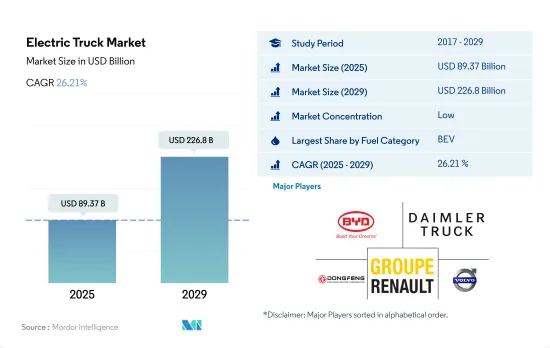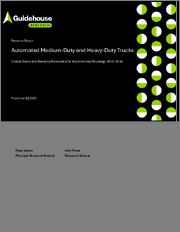
|
시장보고서
상품코드
1693627
세계의 전기 트럭 시장 : 점유율 분석, 산업 동향 및 통계, 성장 예측(2025-2030년)Electric Truck - Market Share Analysis, Industry Trends & Statistics, Growth Forecasts (2025 - 2030) |
||||||
■ 보고서에 따라 최신 정보로 업데이트하여 보내드립니다. 배송일정은 문의해 주시기 바랍니다.
세계의 전기 트럭 시장 규모는 2025년 893억 7,000만 달러로 추정되고, 2029년에는 2,268억 달러에 이를 것으로 예측되며, 예측 기간 중(2025-2029년) CAGR 26.21%로 성장할 것으로 예측됩니다.

전기 중형 및 대형 트럭 세계 시장은 보다 깨끗한 수송 솔루션의 필요성에 뒷받침되어 큰 성장이 전망됩니다.
- 중형 및 대형 부문을 커버하는 세계의 전기 트럭 시장은 지속가능한 화물 및 물류 솔루션에 대한 수요 증가를 반영하여 2023년에 큰 성장을 이루었습니다. 이 확장은 운송 배출을 억제하는 긴급한 필요와 차량 전동화의 세계 추진에 대한 직접적인 반응입니다. 2024년에는 전기자동차(EV) 기술의 진보, 배터리 비용의 저하, 보다 깨끗한 상업 수송을 중시하는 환경규제의 강화에 힘입어 시장은 성장세를 유지할 전망입니다.
- EV 구매 장려금, 충전 인프라 투자, 물류 및 운송에 있어서의 이산화탄소 배출량 감축의 의무화 등 세계 각국의 정부 정책이 전기 트럭 채용 증가를 뒷받침하고 있습니다. 이러한 조치는 기업의 지속가능성에 대한 관심이 증가함에 따라 전기 트럭으로의 전환을 가속화하고 있습니다. 기업은 운영을 환경 목표와 일치시키고 친환경 공급망에 대한 소비자의 기대에 부응하고 있습니다.
- 향후 몇 년간 세계의 전기 트럭 시장은 보다 효율적이고 항속 거리가 긴 전기 트럭의 개발에 있어서 자동차 제조업체의 투자 증가에 의해 강력한 성장이 전망될 예정입니다. 트럭은 보다 폭넓은 수송 용도로 점점 실행 가능하게 되고 있습니다.
전 세계적으로 전기 트럭 시장은 기술 발전, 규제 정책 및 지속가능성을 위한 시장 역학의 변화로 인해 전 지역에서 큰 성장을 경험하고 있습니다.
- 중국 시장에서의 압도적인 존재감, 야심적인 환경 정책, EV 기술과 인프라에 대한 많은 투자가 아시아태평양을 세계 전기 트럭 시장의 최전선으로 밀어 올리고 있습니다.
- 유럽의 전기 트럭 시장은 엄격한 배출 규제, 환경 지속가능성에 대한 강한 관심, 운송 부문에서의 카본 풋 프린트 삭감의 야심적인 목표로 두드러지고 있습니다.
- 북미의 전기 트럭 시장은 규제 이니셔티브, 기술적 진보 및 진화하는 소비자 선호의 믹스에 의해 서서히 성장하고 있습니다.
- 남미의 전기 트럭 시장은 아직 시작되었고, 브라질이나 칠레 같은 국가들이 경제 변동이나 인프라 격차와 같은 과제에도 불구하고, 전동화의 선진을 끊고 있습니다.
전기 트럭 시장 동향
세계 수요 증가와 정부 지원이 전기차 시장 성장을 뒷받침
- 전기자동차(EV)는 에너지 효율을 높이고 온실가스와 공해의 배출을 삭감할 가능성에 힘입어 자동차 산업에 있어서 필수적인 요소가 되고 있습니다. EV의 세계 판매 대수는 2021년에 비해 2022년에는 10.82% 증가하고 견조한 성장을 보였습니다.
- 런던 경시청 소방국과 같은 선도적인 제조업체와 조직은 전동 이동성 전략을 적극적으로 추진하고 있습니다.
- 아시아태평양과 유럽은 배터리기술과 차량전화의 진보에 견인되어 전기자동차 생산을 지배하는 태세를 갖추고 있습니다. 2020년 5월 Kia Motors Europe은 '플랜 S'를 발표하고 전기화로의 전략적 변화를 표명했습니다. 이 결정은 Kia의 EV가 유럽에서 기록적인 판매 대수를 달성한 것에 따라 이루어졌습니다. Kia는 2025년까지 승용차, SUV, MPV 등 다양한 부문에 걸쳐 11개의 EV 모델을 세계에 투입한다는 야심찬 계획을 내걸고 있습니다. 이 회사는 2026년까지 EV의 세계 연간 판매 대수 50만대의 달성을 목표로 하고 있습니다.
전기 트럭 산업 개요
전기 트럭 시장은 단편화되어 상위 5개사에서 21.50%를 차지하고 있습니다. 이 시장 주요 기업은 BYD Auto Co. Ltd., Daimler Truck Holding AG, Dongfeng Motor Corporation, Groupe Renault and Volvo Group입니다(알파벳순).
기타 혜택
- 엑셀 형식 시장 예측(ME) 시트
- 3개월의 애널리스트 서포트
목차
제1장 주요 요약과 주요 조사 결과
제2장 보고서 제안
제3장 소개
- 조사의 전제조건과 시장 정의
- 조사 범위
- 조사 방법
제4장 주요 산업 동향
- 인구
- 아프리카
- 아시아태평양
- 유럽
- 중동
- 북미
- 남미
- 1인당 GDP
- 아프리카
- 아시아태평양
- 유럽
- 중동
- 북미
- 남미
- 자동차 구입을 위한 소비 지출(cvp)
- 아프리카
- 아시아태평양
- 유럽
- 중동
- 북미
- 남미
- 인플레이션율
- 아프리카
- 아시아태평양
- 유럽
- 중동
- 북미
- 남미
- 자동차 대출 금리
- 전화의 영향
- EV 충전소
- 배터리 팩 가격
- 아프리카
- 아시아태평양
- 유럽
- 중동
- 북미
- 남미
- Xev 신모델 발표
- 물류 성능 인덱스
- 아프리카
- 아시아태평양
- 유럽
- 중동
- 북미
- 남미
- 연료 가격
- 제조업체별 생산 통계
- 규제 프레임워크
- 밸류체인과 유통채널 분석
제5장 시장 세분화
- 차량 구성
- 트럭
- 대형 상용 트럭
- 중형 상용 트럭
- 트럭
- 연료 카테고리
- BEV
- FCEV
- HEV
- PHEV
- 지역
- 아프리카
- 남아프리카
- 아시아태평양
- 중국
- 인도
- 일본
- 한국
- 유럽
- 프랑스
- 독일
- 이탈리아
- 스페인
- 기타 유럽
- 중동
- 기타 중동
- 북미
- 캐나다
- 멕시코
- 미국
- 남미
- 브라질
- 기타 남미
- 아프리카
제6장 경쟁 구도
- 주요 전략 동향
- 시장 점유율 분석
- 기업 상황
- 기업 프로파일
- BYD Auto Co. Ltd.
- Daimler Truck Holding AG
- Dongfeng Motor Corporation
- Groupe Renault
- Hino Motors Ltd.
- Isuzu Motors Limited
- Navistar International Transportation Corporation
- PACCAR Inc.
- Scania AB
- Volvo Group
제7장 CEO에 대한 주요 전략적 질문
제8장 부록
- 세계 개요
- 개요
- Porter's Five Forces 분석 프레임워크
- 세계의 밸류체인 분석
- 시장 역학(DROs)
- 정보원과 참고문헌
- 도표 일람
- 주요 인사이트
- 데이터 팩
- 용어집
The Electric Truck Market size is estimated at 89.37 billion USD in 2025, and is expected to reach 226.8 billion USD by 2029, growing at a CAGR of 26.21% during the forecast period (2025-2029).

The global market for electric medium and heavy-duty trucks is poised for significant growth, driven by the imperative for cleaner transportation solutions
- The global electric truck market, covering medium and heavy-duty segments, witnessed significant growth in 2023, reflecting a rising demand for sustainable freight and logistics solutions. This expansion is a direct response to the urgent need to curb transportation emissions and the global push for vehicle electrification. In 2024, the market is poised to sustain its growth momentum, propelled by advancements in electric vehicle (EV) technology, falling battery costs, and stricter environmental regulations emphasizing cleaner commercial transportation.
- Government policies worldwide, such as EV purchase incentives, investments in charging infrastructure, and mandates to reduce carbon footprints in logistics and transportation, are bolstering the upswing in electric truck adoption. These measures, coupled with a growing corporate focus on sustainability, are hastening the shift to electric trucks. Businesses are aligning their operations with environmental goals and meeting consumer expectations for greener supply chains.
- In the coming years, the global electric truck market is set for robust growth, fueled by increased investments from vehicle manufacturers in developing more efficient and longer-range electric trucks. Ongoing advancements in EV technology are making electric trucks increasingly viable across a broader range of transport applications. As more cities and countries establish low-emission zones and zero-emission logistics targets, the demand for electric trucks is poised to surge.
Globally, the electric truck market is experiencing significant growth across all regions, driven by technological advancements, regulatory policies, and shifting market dynamics toward sustainability
- China's dominant market presence, ambitious environmental policies, and significant investments in EV technology and infrastructure are propelling the APAC region to the forefront of the global electric truck market. Japan and South Korea are also key players, emphasizing innovation and supportive policies for electric vehicle adoption. The APAC market benefits from robust government subsidies, rapid technological advancements, and a heightened recognition of the importance of sustainable transportation.
- The European electric truck market stands out for its stringent emissions regulations, strong focus on environmental sustainability, and ambitious targets for reducing carbon footprints in the transport sector. The European Union's Green Deal and its pro-zero-emission vehicle policies have further expedited the adoption of electric trucks across the continent. European manufacturers and logistics firms are swiftly embracing electric trucks to align with these regulations.
- The North American electric truck market is growing gradually, driven by a mix of regulatory initiatives, technological advancements, and evolving consumer preferences. The United States and Canada are intensifying their efforts to curb greenhouse gas emissions from transportation, offering incentives at federal and state levels to promote electric vehicle adoption.
- The South American electric truck market is nascent, with countries like Brazil and Chile spearheading electrification despite challenges such as economic volatility and infrastructure gaps. The introduction of electric buses in these countries has laid the groundwork for the broader adoption of electric commercial vehicles, including trucks.
Electric Truck Market Trends
The rising global demand and government support propel electric vehicle market growth
- Electric vehicles (EVs) have become indispensable in the automotive industry, driven by their potential to enhance energy efficiency and reduce greenhouse gas and pollution emissions. This surge is primarily attributed to growing environmental concerns and supportive government initiatives. Notably, global EV sales witnessed a robust 10.82% growth in 2022 compared to 2021. Projections indicate that annual sales of electric passenger cars will surpass 5 million by the end of 2025, accounting for approximately 15% of total vehicle sales.
- Leading manufacturers and organizations, like the London Metropolitan Police & Fire Service, have been actively pursuing their electric mobility strategies. For instance, they have set a target of a zero-emission fleet by 2025, with a goal of electrifying 40% of their vans by 2030 and achieving full electrification by 2040. Similar trends are expected globally, with the period from 2024 to 2030 witnessing a surge in demand and sales of electric vehicles.
- Asia-Pacific and Europe are poised to dominate electric vehicle production, driven by their advancements in battery technology and vehicle electrification. In May 2020, Kia Motors Europe unveiled its "Plan S," signaling a strategic shift toward electrification. This decision came on the heels of record-breaking sales of Kia's EVs in Europe. Kia has ambitious plans to introduce 11 EV models globally by 2025, spanning various segments like passenger vehicles, SUVs, and MPVs. The company aims to achieve annual global EV sales of 500,000 by 2026.
Electric Truck Industry Overview
The Electric Truck Market is fragmented, with the top five companies occupying 21.50%. The major players in this market are BYD Auto Co. Ltd., Daimler Truck Holding AG, Dongfeng Motor Corporation, Groupe Renault and Volvo Group (sorted alphabetically).
Additional Benefits:
- The market estimate (ME) sheet in Excel format
- 3 months of analyst support
TABLE OF CONTENTS
1 EXECUTIVE SUMMARY & KEY FINDINGS
2 REPORT OFFERS
3 INTRODUCTION
- 3.1 Study Assumptions & Market Definition
- 3.2 Scope of the Study
- 3.3 Research Methodology
4 KEY INDUSTRY TRENDS
- 4.1 Population
- 4.1.1 Africa
- 4.1.2 Asia-Pacific
- 4.1.3 Europe
- 4.1.4 Middle East
- 4.1.5 North America
- 4.1.6 South America
- 4.2 GDP Per Capita
- 4.2.1 Africa
- 4.2.2 Asia-Pacific
- 4.2.3 Europe
- 4.2.4 Middle East
- 4.2.5 North America
- 4.2.6 South America
- 4.3 Consumer Spending For Vehicle Purchase (cvp)
- 4.3.1 Africa
- 4.3.2 Asia-Pacific
- 4.3.3 Europe
- 4.3.4 Middle East
- 4.3.5 North America
- 4.3.6 South America
- 4.4 Inflation
- 4.4.1 Africa
- 4.4.2 Asia-Pacific
- 4.4.3 Europe
- 4.4.4 Middle East
- 4.4.5 North America
- 4.4.6 South America
- 4.5 Interest Rate For Auto Loans
- 4.6 Impact Of Electrification
- 4.7 EV Charging Station
- 4.8 Battery Pack Price
- 4.8.1 Africa
- 4.8.2 Asia-Pacific
- 4.8.3 Europe
- 4.8.4 Middle East
- 4.8.5 North America
- 4.8.6 South America
- 4.9 New Xev Models Announced
- 4.10 Logistics Performance Index
- 4.10.1 Africa
- 4.10.2 Asia-Pacific
- 4.10.3 Europe
- 4.10.4 Middle East
- 4.10.5 North America
- 4.10.6 South America
- 4.11 Fuel Price
- 4.12 Oem-wise Production Statistics
- 4.13 Regulatory Framework
- 4.14 Value Chain & Distribution Channel Analysis
5 MARKET SEGMENTATION (includes market size in Value in USD and Volume, Forecasts up to 2029 and analysis of growth prospects)
- 5.1 Vehicle Configuration
- 5.1.1 Trucks
- 5.1.1.1 Heavy-duty Commercial Trucks
- 5.1.1.2 Medium-duty Commercial Trucks
- 5.1.1 Trucks
- 5.2 Fuel Category
- 5.2.1 BEV
- 5.2.2 FCEV
- 5.2.3 HEV
- 5.2.4 PHEV
- 5.3 Region
- 5.3.1 Africa
- 5.3.1.1 South Africa
- 5.3.2 Asia-Pacific
- 5.3.2.1 China
- 5.3.2.2 India
- 5.3.2.3 Japan
- 5.3.2.4 South Korea
- 5.3.3 Europe
- 5.3.3.1 France
- 5.3.3.2 Germany
- 5.3.3.3 Italy
- 5.3.3.4 Spain
- 5.3.3.5 Rest-of-Europe
- 5.3.4 Middle East
- 5.3.4.1 Rest-of-Middle East
- 5.3.5 North America
- 5.3.5.1 Canada
- 5.3.5.2 Mexico
- 5.3.5.3 US
- 5.3.6 South America
- 5.3.6.1 Brazil
- 5.3.6.2 Rest-of-South America
- 5.3.1 Africa
6 COMPETITIVE LANDSCAPE
- 6.1 Key Strategic Moves
- 6.2 Market Share Analysis
- 6.3 Company Landscape
- 6.4 Company Profiles
- 6.4.1 BYD Auto Co. Ltd.
- 6.4.2 Daimler Truck Holding AG
- 6.4.3 Dongfeng Motor Corporation
- 6.4.4 Groupe Renault
- 6.4.5 Hino Motors Ltd.
- 6.4.6 Isuzu Motors Limited
- 6.4.7 Navistar International Transportation Corporation
- 6.4.8 PACCAR Inc.
- 6.4.9 Scania AB
- 6.4.10 Volvo Group
7 KEY STRATEGIC QUESTIONS FOR VEHICLES CEOS
8 APPENDIX
- 8.1 Global Overview
- 8.1.1 Overview
- 8.1.2 Porter's Five Forces Framework
- 8.1.3 Global Value Chain Analysis
- 8.1.4 Market Dynamics (DROs)
- 8.2 Sources & References
- 8.3 List of Tables & Figures
- 8.4 Primary Insights
- 8.5 Data Pack
- 8.6 Glossary of Terms
샘플 요청 목록



















